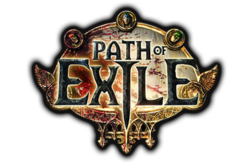Path of Exile
| Path of Exile | |
|---|---|
 |
|
| Developer(s) | Grinding Gear Games |
| Publisher(s) | Grinding Gear Games |
| Designer(s) | Chris Wilson |
| Programmer(s) | Jonathan Rogers |
| Artist(s) | Erik Olofsson |
| Writer(s) | Edwin McRae Brian Weissman |
| Composer(s) | Adgio Hutchings Kamil Orman-Janowski |
| Platform(s) | Microsoft Windows Xbox One |
| Release date(s) |
Microsoft Windows 23 October 2013 Xbox One 2017 |
| Genre(s) | Action role-playing |
| Mode(s) | Single-player, multiplayer |
| Aggregate score | |
|---|---|
| Aggregator | Score |
| Metacritic | 86/100 |
| Review scores | |
| Publication | Score |
| Eurogamer | 7/10 |
| GameSpot | 9/10 |
| IGN | 8.8/10 |
Path of Exile is an online action role-playing game developed and published by Grinding Gear Games. It is a free-to-play title supported by microtransactions. An open beta was released on 23 January 2013, and the game was officially released on 23 October 2013.
The player controls a single character from an overhead perspective and explores large outdoor areas and underground caves or dungeons, battling monsters and fulfilling quests from NPCs to gain experience points and equipment. The game borrows heavily from the Diablo series, particularly Diablo II. All areas aside from the central encampments are randomly generated for increased re-playability. While all players on a single server can freely mingle in encampments, gameplay outside of encampments is highly instanced, providing every player or party with an isolated map to freely explore.
Players can initially choose from six available classes to play as (Duelist, Marauder, Ranger, Shadow, Templar, and Witch). Each of these classes are aligned with one or two of the three core attributes, Strength, Dexterity, or Intelligence. The final class, the Scion, can be unlocked by freeing her near the end of Act 3 on Normal difficulty, and is aligned with all three attributes. The different classes are not restricted from investing into skills not aligned with their core attributes, but will have easier access to skills that are aligned with their core attributes. Items are randomly generated from a wide variety of basic types and endowed with special properties and gem sockets. They come in different rarities with increasingly powerful properties. This makes a large part of gameplay dedicated to finding well-balanced and synergistic equipment. Skill gems can be placed in gem sockets of armor and weapons, giving them an active skill. As the character advances and levels up, the equipped skill gems also gain experience, allowing the skills themselves to be levelled up and increase in potency.
Active skills can be modified by items known as Support Gems. Depending upon the number of linked sockets the player possesses, a primary attack or skill can be modified with increased attack speed, faster projectiles, multiple projectiles, chaining hits, life leech, auto-cast spells on critical strike, and more. Given limits on the number of sockets, players must prioritize gem usage. All classes share the same selection of 1,325 passive skills, from which the player can choose one each time their character levels up, and as an occasional quest reward. These passive skills improve the core attributes and grant further enhancements such as increased Mana, Health, damage, defenses, regeneration, speed, and more. Each one of the characters start on a different position on the passive skill tree. The passive skill tree is arranged in a complex network starting in separate trunks for each class (aligned with the permutations of the three core attributes). The player must therefore not only focus on maximizing all modifiers related to his primary offense and defense, but must also take care to select the most efficient path through the passive skill tree. As of the 2.0 Awakening Release, the maximum possible number of passive skill points per character was 123 (99 from leveling and 24 from quest rewards.)
...
Wikipedia
